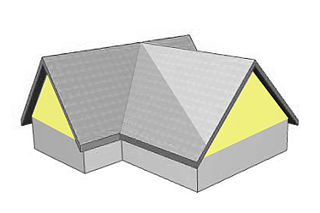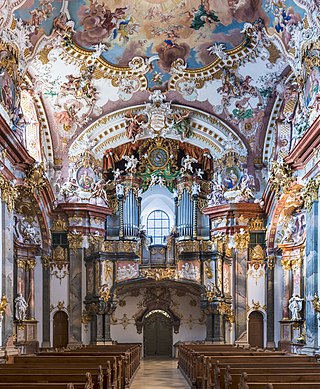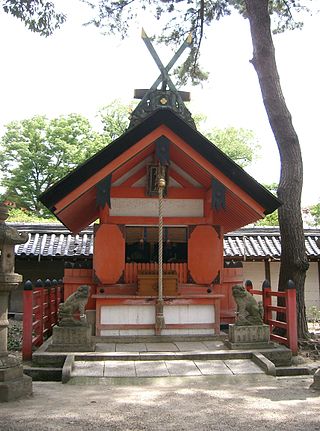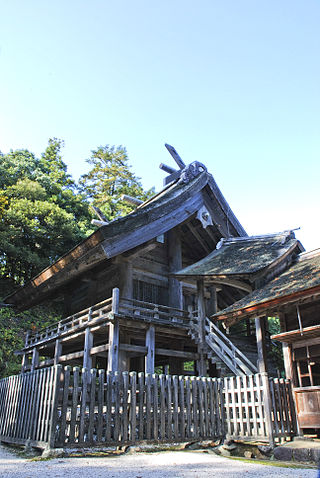Related Research Articles

In architecture, a cupola is a relatively small, most often dome-like, tall structure on top of a building. Often used to provide a lookout or to admit light and air, it usually crowns a larger roof or dome.

A trefoil is a graphic form composed of the outline of three overlapping rings, used in architecture, Pagan and Christian symbolism, among other areas. The term is also applied to other symbols with a threefold shape. A similar shape with four rings is called a quatrefoil.

In architecture, and specifically Gothic architecture, a gargoyle is a carved or formed grotesque with a spout designed to convey water from a roof and away from the side of a building, thereby preventing it from running down masonry walls and eroding the mortar between. Architects often used multiple gargoyles on a building to divide the flow of rainwater off the roof to minimize potential damage from rainstorms. A trough is cut in the back of the gargoyle and rainwater typically exits through the open mouth. Gargoyles are usually elongated fantastical animals because their length determines how far water is directed from the wall. When Gothic flying buttresses were used, aqueducts were sometimes cut into the buttress to divert water over the aisle walls.

In classical architecture, a pilaster is an architectural element used to give the appearance of a supporting column and to articulate an extent of wall, with only an ornamental function. It consists of a flat surface raised from the main wall surface, usually treated as though it were a column, with a capital at the top, plinth (base) at the bottom, and the various other column elements. In contrast to a pilaster, an engaged column or buttress can support the structure of a wall and roof above.

Ornamental plants or garden plants are plants that are primarily grown for their beauty but also for qualities such as scent or how they shape physical space. Many flowering plants and garden varieties tend to be specially bred cultivars that improve on the original species in qualities such as color, shape, scent, and long-lasting blooms. There are many examples of fine ornamental plants that can provide height, privacy, and beauty for any garden. These ornamental perennial plants have seeds that allow them to reproduce. One of the beauties of ornamental grasses is that they are very versatile and low maintenance. Almost any types of plant have ornamental varieties: trees, shrubs, climbers, grasses, succulents, aquatic plants, herbaceous perennials and annual plants. Non-botanical classifications include houseplants, bedding plants, hedges, plants for cut flowers and foliage plants. The cultivation of ornamental plants comes under floriculture and tree nurseries, which is a major branch of horticulture.

An archivolt is an ornamental moulding or band following the curve on the underside of an arch. It is composed of bands of ornamental mouldings surrounding an arched opening, corresponding to the architrave in the case of a rectangular opening. The word is sometimes used to refer to the under-side or inner curve of the arch itself. Most commonly archivolts are found as a feature of the arches of church portals. The mouldings and sculptures on these archivolts are used to convey a theological story or depict religious figures and ideologies of the church in order to represent the gateway between the holy space of the church and the external world. The presence of archivolts on churches is seen throughout history, although their design, both architecturally and artistically, is heavily influenced by the period they were built in and the churches they were designed for.

A gable is the generally triangular portion of a wall between the edges of intersecting roof pitches. The shape of the gable and how it is detailed depends on the structural system used, which reflects climate, material availability, and aesthetic concerns. The term gable wall or gable end more commonly refers to the entire wall, including the gable and the wall below it. Some types of roof do not have a gable. One common type of roof with gables, the gable roof, is named after its prominent gables.

Mudéjar art, also known as Mudéjar style, refers to a type of ornamentation and decoration used in the Iberian Christian kingdoms, primarily between the 13th and 16th centuries. It was applied to Romanesque, Gothic, and Renaissance architectural styles as constructive, ornamental, and decorative motifs derived from those that had been brought to or developed in Al-Andalus. These motifs and techniques were also present in the art and crafts, especially Hispano-Moresque lustreware that was once widely exported across Europe from southern and eastern Spain at the time.

In architecture and decorative art, ornament is decoration used to embellish parts of a building or object. Large figurative elements such as monumental sculpture and their equivalents in decorative art are excluded from the term; most ornaments do not include human figures, and if present they are small compared to the overall scale. Architectural ornament can be carved from stone, wood or precious metals, formed with plaster or clay, or painted or impressed onto a surface as applied ornament; in other applied arts the main material of the object, or a different one such as paint or vitreous enamel may be used.

Kantanagar Temple, commonly known as Kantaji Temple or Kantajew Temple at Kantanagar, is a late-medieval Hindu temple in Dinajpur, Bangladesh. The Kantajew Temple is a religious edifice belonging to the 18th century. The temple belongs to the Hindu Kanta or Krishna and this is most popular with the Radha-Krishna cult in Bengal. This temple is dedicated to Krishna and his wife Rukmini. Built by Maharaja Pran Nath, its construction started in 1704 CE and ended in the reign of his son Raja Ramnath in 1722 CE. It is an example of terracotta architecture in Bangladesh and once had nine spires, but all were destroyed in an earthquake that took place in 1897.

The Pompeian Styles are four periods which are distinguished in ancient Roman mural painting. They were originally delineated and described by the German archaeologist August Mau (1840–1909) from the excavation of wall paintings at Pompeii, which is one of the largest groups of surviving Roman frescoes.

The Louisville Water Tower, located east of downtown Louisville, Kentucky near the riverfront, is the oldest ornamental water tower in the world, having been built before the more famous Chicago Water Tower. Both the actual water tower and its pumping station are a designated National Historic Landmark for their architecture. As with the Fairmount Water Works of Philadelphia, the industrial nature of its pumping station was disguised in the form of a Roman temple complex.

The Great Mosque of Tlemcen is a major historic mosque in Tlemcen, Algeria. It was founded and first built in 1082 but modified and embellished several times afterwards. It is considered one of the most important examples of architecture under the Almoravid dynasty.

Sumiyoshi-zukuri (住吉造) is an ancient Japanese Shinto shrine architectural style which takes its name from Sumiyoshi Taisha's honden in Ōsaka. As in the case of the taisha-zukuri and shinmei-zukuri styles, its birth predates the arrival of Buddhism in Japan.

Vigas are wooden beams used in the traditional adobe architecture of the American Southwest, especially New Mexico. In this type of construction, the vigas are the main structural members carrying the weight of the roof to the load-bearing exterior walls. The exposed beam ends projecting from the outside of the wall are a defining characteristic of Pueblo architecture and Spanish Colonial architecture in New Mexico and often replicated in modern Pueblo Revival architecture. Usually the vigas are simply peeled logs with a minimum of woodworking. In traditional buildings, the vigas support latillas (laths) which are placed crosswise and upon which the adobe roof is laid, often with intermediate layers of brush or soil. The latillas may be hewn boards, or in more rustic buildings, simply peeled branches. These building techniques date back to the Ancestral Puebloan peoples, and vigas are visible in many of their surviving buildings.

Taisha-zukuri or Ōyashiro-zukuri (大社造) is an ancient Japanese architectural style and the oldest Shinto shrine architectural style. Named after Izumo Taisha's honden (sanctuary), like Ise Grand Shrine's shinmei-zukuri style it features a bark roof decorated with poles called chigi and katsuogi, plus archaic features like gable-end pillars and a single central pillar. The honden's floor is raised above the ground through the use of stilts . Like the shinmei-zukuri and sumiyoshi-zukuri styles, it predates the arrival of Buddhism in Japan.

Kasuga-zukuri (春日造) is a traditional Shinto shrine architectural style which takes its name from Kasuga Taisha's honden.

The Surfcomber Hotel is a boutique hotel on Collins Avenue in the historic Art Deco district of South Beach in Miami Beach, Florida. The hotel was built in 1948 and was acquired by the Kimpton hotel chain in April 2011. The Surfcomber is known for pool parties, and it served as the headquarters for MTV during the 2005 MTV Video Music Awards and for Bud Light during Super Bowl XLIV in 2010. The hotel is located at 1717 Collins Avenue, on the shore of Miami's South Beach.

A lintel or lintol is a type of beam that spans openings such as portals, doors, windows and fireplaces. It can be a decorative architectural element, or a combined ornamented/structural item. In the case of windows, the bottom span is referred to as a sill, but, unlike a lintel, does not serve to bear a load to ensure the integrity of the wall. Modern-day lintels may be made using prestressed concrete and are also referred to as beams in beam-and-block slabs or as ribs in rib-and-block slabs. These prestressed concrete lintels and blocks can serve as components that are packed together and propped to form a suspended-floor concrete slab.

Sebka refers to a type of decorative motif used in western Islamic ("Moorish") architecture and Mudéjar architecture.
References
- ↑ JAMES STEVENS CURL. "Ornamentalism." A Dictionary of Architecture and Landscape Architecture. 2000. Encyclopedia.com. (January 5, 2013).http://www.encyclopedia.com/doc/1O1-Ornamentalism.html